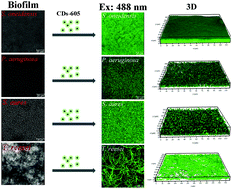Imaging biofilm-encased microorganisms using carbon dots derived from L. plantarum†
Abstract
Imaging biofilm-encased microorganisms is challenging due to them being shielded by a sticky and strong extracellular polymeric substance matrix that blocks the penetration of dyes, but is especially important for biofilm study. Here, carbon dots, namely CDs-605, were used for successfully imaging biofilm-encased microorganisms. We demonstrated that such CDs-605 could be easily synthesized from L. plantarum by one-step hydrothermal carbonization. The negatively charged CDs-605 were composed of C, H, O, N, P, and S and contained various functional groups, including –OH, –COOH, and –CONH–. For the first time, CDs-605 were found to be capable of imaging biofilm-encased microorganisms, including E. coli, S. oneidensis, P. aeruginosa, S. aures, and T. reesei, demonstrating that the labeling is universal. The labeling method based on CDs-605 did not require incubation, protection from light, or washing, which makes it very convenient. Additionally, CDs-605 did not disturb the biofilm and displayed better photostability compared to the commercial counterpart. CDs-605 can serve as a simple, yet powerful staining agent for biofilm-embedded microorganism imaging, which is vital for gaining a fundamental understanding of biofilm formation and dispersal.



 Please wait while we load your content...
Please wait while we load your content...